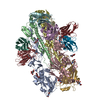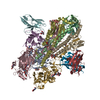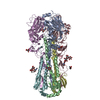[English] 日本語
 Yorodumi
Yorodumi- EMDB-25039: Structure of H1 NC99 influenza hemagglutinin bound to Fab 310-63E6 -
+ Open data
Open data
- Basic information
Basic information
| Entry |  | |||||||||
|---|---|---|---|---|---|---|---|---|---|---|
| Title | Structure of H1 NC99 influenza hemagglutinin bound to Fab 310-63E6 | |||||||||
 Map data Map data | Cryo-EM map of Fab 310-63E6 bound to H1 NC99 influenza hemagglutinin | |||||||||
 Sample Sample |
| |||||||||
| Function / homology |  Function and homology information Function and homology information viral budding from plasma membrane / clathrin-dependent endocytosis of virus by host cell / host cell surface receptor binding / fusion of virus membrane with host plasma membrane / fusion of virus membrane with host endosome membrane / viral budding from plasma membrane / clathrin-dependent endocytosis of virus by host cell / host cell surface receptor binding / fusion of virus membrane with host plasma membrane / fusion of virus membrane with host endosome membrane /  viral envelope / virion attachment to host cell / host cell plasma membrane / virion membrane / viral envelope / virion attachment to host cell / host cell plasma membrane / virion membrane /  membrane membraneSimilarity search - Function | |||||||||
| Biological species |    Influenza A virus / Influenza A virus /   Influenza A virus (strain A/New Zealand:South Canterbury/35/2000 H1N1) / Influenza A virus (strain A/New Zealand:South Canterbury/35/2000 H1N1) /   Homo sapiens (human) Homo sapiens (human) | |||||||||
| Method |  single particle reconstruction / single particle reconstruction /  cryo EM / Resolution: 3.02 Å cryo EM / Resolution: 3.02 Å | |||||||||
 Authors Authors | Ward A / Torrents de la Pena A | |||||||||
| Funding support |  United States, 2 items United States, 2 items
| |||||||||
 Citation Citation |  Journal: Immunity / Year: 2022 Journal: Immunity / Year: 2022Title: Allelic polymorphism controls autoreactivity and vaccine elicitation of human broadly neutralizing antibodies against influenza virus. Authors: Maya Sangesland / Alba Torrents de la Peña / Seyhan Boyoglu-Barnum / Larance Ronsard / Faez Amokrane Nait Mohamed / Thalia Bracamonte Moreno / Ralston M Barnes / Daniel Rohrer / Nils ...Authors: Maya Sangesland / Alba Torrents de la Peña / Seyhan Boyoglu-Barnum / Larance Ronsard / Faez Amokrane Nait Mohamed / Thalia Bracamonte Moreno / Ralston M Barnes / Daniel Rohrer / Nils Lonberg / Musie Ghebremichael / Masaru Kanekiyo / Andrew Ward / Daniel Lingwood /  Abstract: Human broadly neutralizing antibodies (bnAbs) targeting the hemagglutinin stalk of group 1 influenza A viruses (IAVs) are biased for IGHV1-69 alleles that use phenylalanine (F54) but not leucine (L54) ...Human broadly neutralizing antibodies (bnAbs) targeting the hemagglutinin stalk of group 1 influenza A viruses (IAVs) are biased for IGHV1-69 alleles that use phenylalanine (F54) but not leucine (L54) within their CDRH2 loops. Despite this, we demonstrated that both alleles encode for human IAV bnAbs that employ structurally convergent modes of contact to the same epitope. To resolve differences in lineage expandability, we compared F54 versus L54 as substrate within humanized mice, where antibodies develop with human-like CDRH3 diversity but are restricted to single V genes. While both alleles encoded for bnAb precursors, only F54 IGHV1-69 supported elicitation of heterosubtypic serum bnAbs following immunization with a stalk-only nanoparticle vaccine. L54 IGHV1-69 was unproductive, co-encoding for anergic B cells and autoreactive stalk antibodies that were cleared from B cell memory. Moreover, human stalk antibodies also demonstrated L54-dependent autoreactivity. Therefore, IGHV1-69 polymorphism, which is skewed ethnically, gates tolerance and vaccine expandability of influenza bnAbs. | |||||||||
| History |
|
- Structure visualization
Structure visualization
| Supplemental images |
|---|
- Downloads & links
Downloads & links
-EMDB archive
| Map data |  emd_25039.map.gz emd_25039.map.gz | 117.3 MB |  EMDB map data format EMDB map data format | |
|---|---|---|---|---|
| Header (meta data) |  emd-25039-v30.xml emd-25039-v30.xml emd-25039.xml emd-25039.xml | 18 KB 18 KB | Display Display |  EMDB header EMDB header |
| Images |  emd_25039.png emd_25039.png | 67.4 KB | ||
| Archive directory |  http://ftp.pdbj.org/pub/emdb/structures/EMD-25039 http://ftp.pdbj.org/pub/emdb/structures/EMD-25039 ftp://ftp.pdbj.org/pub/emdb/structures/EMD-25039 ftp://ftp.pdbj.org/pub/emdb/structures/EMD-25039 | HTTPS FTP |
-Related structure data
| Related structure data |  7scnMC  7scoC M: atomic model generated by this map C: citing same article ( |
|---|---|
| Similar structure data | Similarity search - Function & homology  F&H Search F&H Search |
- Links
Links
| EMDB pages |  EMDB (EBI/PDBe) / EMDB (EBI/PDBe) /  EMDataResource EMDataResource |
|---|---|
| Related items in Molecule of the Month |
- Map
Map
| File |  Download / File: emd_25039.map.gz / Format: CCP4 / Size: 125 MB / Type: IMAGE STORED AS FLOATING POINT NUMBER (4 BYTES) Download / File: emd_25039.map.gz / Format: CCP4 / Size: 125 MB / Type: IMAGE STORED AS FLOATING POINT NUMBER (4 BYTES) | ||||||||||||||||||||
|---|---|---|---|---|---|---|---|---|---|---|---|---|---|---|---|---|---|---|---|---|---|
| Annotation | Cryo-EM map of Fab 310-63E6 bound to H1 NC99 influenza hemagglutinin | ||||||||||||||||||||
| Voxel size | X=Y=Z: 1.15 Å | ||||||||||||||||||||
| Density |
| ||||||||||||||||||||
| Symmetry | Space group: 1 | ||||||||||||||||||||
| Details | EMDB XML:
|
-Supplemental data
- Sample components
Sample components
-Entire : Structure of H1 NC99 influenza hemagglutinin bound to 310-63E6 Fab
| Entire | Name: Structure of H1 NC99 influenza hemagglutinin bound to 310-63E6 Fab |
|---|---|
| Components |
|
-Supramolecule #1: Structure of H1 NC99 influenza hemagglutinin bound to 310-63E6 Fab
| Supramolecule | Name: Structure of H1 NC99 influenza hemagglutinin bound to 310-63E6 Fab type: complex / ID: 1 / Parent: 0 / Macromolecule list: #1-#4 |
|---|---|
| Source (natural) | Organism:    Influenza A virus Influenza A virus |
| Recombinant expression | Organism:   Homo sapiens (human) / Recombinant cell: 293F Homo sapiens (human) / Recombinant cell: 293F |
-Macromolecule #1: Hemagglutinin HA1 chain
| Macromolecule | Name: Hemagglutinin HA1 chain / type: protein_or_peptide / ID: 1 / Number of copies: 3 / Enantiomer: LEVO |
|---|---|
| Source (natural) | Organism:   Influenza A virus (strain A/New Zealand:South Canterbury/35/2000 H1N1) Influenza A virus (strain A/New Zealand:South Canterbury/35/2000 H1N1)Strain: A/New Zealand:South Canterbury/35/2000 H1N1 |
| Molecular weight | Theoretical: 35.932309 KDa |
| Recombinant expression | Organism:   Homo sapiens (human) Homo sapiens (human) |
| Sequence | String: DTICIGYHAN NSTDTVDTVL EKNVTVTHSV NLLEDSHNGK LCLLKGIAPL QLGNCSVAGW ILGNPECELL ISKESWSYIV ETPNPENGT CYPGYFADYE ELREQLSSVS SFERFEIFPK ESSWPNHTVT GVSASCSHNG KSSFYRNLLW LTGKNGLYPN L SKSYVNNK ...String: DTICIGYHAN NSTDTVDTVL EKNVTVTHSV NLLEDSHNGK LCLLKGIAPL QLGNCSVAGW ILGNPECELL ISKESWSYIV ETPNPENGT CYPGYFADYE ELREQLSSVS SFERFEIFPK ESSWPNHTVT GVSASCSHNG KSSFYRNLLW LTGKNGLYPN L SKSYVNNK EKEVLVLWGV HHPPNIGNQR ALYHTENAYV SVVSSHYSRR FTPEIAKRPK VRDQEGRINY YWTLLEPGDT II FEANGNL IAPWYAFALS RGFGSGIITS NAPMDECDAK CQTPQGAINS SLPFQNVHPV TIGECPKYVR SAKLRMVTGL RNI PS |
-Macromolecule #2: Hemagglutinin HA2 chain
| Macromolecule | Name: Hemagglutinin HA2 chain / type: protein_or_peptide / ID: 2 / Number of copies: 3 / Enantiomer: LEVO |
|---|---|
| Source (natural) | Organism:   Influenza A virus (strain A/New Zealand:South Canterbury/35/2000 H1N1) Influenza A virus (strain A/New Zealand:South Canterbury/35/2000 H1N1)Strain: A/New Zealand:South Canterbury/35/2000 H1N1 |
| Molecular weight | Theoretical: 26.637555 KDa |
| Recombinant expression | Organism:   Homo sapiens (human) Homo sapiens (human) |
| Sequence | String: RETRGLFGAI AGFIEGGWTG MVDGWYGYHH QNEQGSGYAA DQKSTQNAIN GITNKVNSVI EKMNTQFTAV GKEFNKLERR MENLNKKVD DGFLDIWTYN AELLVLLENE RTLDFHDSNV KNLYEKVKSQ LKNNAKEIGN GCFEFYHKCN NECMESVKNG T YDYPKYSE ...String: RETRGLFGAI AGFIEGGWTG MVDGWYGYHH QNEQGSGYAA DQKSTQNAIN GITNKVNSVI EKMNTQFTAV GKEFNKLERR MENLNKKVD DGFLDIWTYN AELLVLLENE RTLDFHDSNV KNLYEKVKSQ LKNNAKEIGN GCFEFYHKCN NECMESVKNG T YDYPKYSE ESKLNREKID GVKYIPEAPR DGQAYVRKDG EWVLLSTFLG SGLNDIFEAQ KIEWHEGHHH HHH |
-Macromolecule #3: 310-63E6 Fab, Heavy Chain
| Macromolecule | Name: 310-63E6 Fab, Heavy Chain / type: protein_or_peptide / ID: 3 / Number of copies: 3 / Enantiomer: LEVO |
|---|---|
| Source (natural) | Organism:   Homo sapiens (human) Homo sapiens (human) |
| Molecular weight | Theoretical: 13.394064 KDa |
| Recombinant expression | Organism:   Homo sapiens (human) Homo sapiens (human) |
| Sequence | String: QVQLVQSGAE VKKPGSSVKV SCTASGGTFS TYQFSWVRQA PGQGLEWMGR IVPIQGMDYA QKFRGRVTIT ADKWTSTVYM EVTSLRSED TAVYYCATSR SMYFYYQLDV WGRGTTVTVS S |
-Macromolecule #4: 310-63E6 Fab, Light Chain
| Macromolecule | Name: 310-63E6 Fab, Light Chain / type: protein_or_peptide / ID: 4 / Number of copies: 3 / Enantiomer: LEVO |
|---|---|
| Source (natural) | Organism:   Homo sapiens (human) Homo sapiens (human) |
| Molecular weight | Theoretical: 11.810081 KDa |
| Recombinant expression | Organism:   Homo sapiens (human) Homo sapiens (human) |
| Sequence | String: EIVLTQSPGT LSLSPGERAT VSCRASQSVT STFLAWYQQR PGQAPRLLIY GASSRATGIP DRFSGSGSEA DFTLTINRLE PEDFAVYYC QQYATSPWTF GQGTKVEIK |
-Macromolecule #5: 2-acetamido-2-deoxy-beta-D-glucopyranose
| Macromolecule | Name: 2-acetamido-2-deoxy-beta-D-glucopyranose / type: ligand / ID: 5 / Number of copies: 15 / Formula: NAG |
|---|---|
| Molecular weight | Theoretical: 221.208 Da |
| Chemical component information |  ChemComp-NAG: |
-Experimental details
-Structure determination
| Method |  cryo EM cryo EM |
|---|---|
 Processing Processing |  single particle reconstruction single particle reconstruction |
| Aggregation state | particle |
- Sample preparation
Sample preparation
| Concentration | 0.2 mg/mL | |||||||||
|---|---|---|---|---|---|---|---|---|---|---|
| Buffer | pH: 7.4 Component:
Details: TBS buffer, PH 7.4 | |||||||||
| Grid | Model: UltrAuFoil R1.2/1.3 / Material: GOLD / Mesh: 300 / Support film - Material: GOLD / Support film - topology: HOLEY / Support film - Film thickness: 50.0 nm | |||||||||
| Vitrification | Cryogen name: ETHANE / Chamber humidity: 100 % / Chamber temperature: 283 K / Instrument: FEI VITROBOT MARK IV Details: Blotting time: 5.5 s Blotting force: 0 Waiting time: 7 s. | |||||||||
| Details | hemagglutinin at 2 mg/ml is complexed with the Fab at a molar ratio 1:3 (HA:Fab). The sample is incubated for 30min at RT and diluted with TBS to a final concentration of 0.2 mg/ml |
- Electron microscopy
Electron microscopy
| Microscope | FEI TALOS ARCTICA |
|---|---|
| Electron beam | Acceleration voltage: 200 kV / Electron source:  FIELD EMISSION GUN FIELD EMISSION GUN |
| Electron optics | C2 aperture diameter: 70.0 µm / Illumination mode: FLOOD BEAM / Imaging mode: BRIGHT FIELD Bright-field microscopy / Cs: 2.7 mm / Nominal magnification: 36000 Bright-field microscopy / Cs: 2.7 mm / Nominal magnification: 36000 |
| Sample stage | Specimen holder model: OTHER / Cooling holder cryogen: NITROGEN |
| Image recording | Film or detector model: GATAN K2 SUMMIT (4k x 4k) / Detector mode: COUNTING / Number grids imaged: 1 / Number real images: 958 / Average exposure time: 10.0 sec. / Average electron dose: 49.88 e/Å2 |
| Experimental equipment |  Model: Talos Arctica / Image courtesy: FEI Company |
- Image processing
Image processing
| CTF correction | Software - Name: Gctf (ver. 1.06) |
|---|---|
| Startup model | Type of model: PDB ENTRY PDB model - PDB ID: |
| Initial angle assignment | Type: PROJECTION MATCHING / Software - Name: RELION (ver. 3.0) |
| Final 3D classification | Number classes: 4 |
| Final angle assignment | Type: ANGULAR RECONSTITUTION / Software - Name: RELION (ver. 3.0) |
| Final reconstruction | Applied symmetry - Point group: C3 (3 fold cyclic ) / Algorithm: BACK PROJECTION / Resolution.type: BY AUTHOR / Resolution: 3.02 Å / Resolution method: FSC 0.143 CUT-OFF / Software - Name: RELION (ver. 3.0) / Number images used: 123683 ) / Algorithm: BACK PROJECTION / Resolution.type: BY AUTHOR / Resolution: 3.02 Å / Resolution method: FSC 0.143 CUT-OFF / Software - Name: RELION (ver. 3.0) / Number images used: 123683 |
 Movie
Movie Controller
Controller











